There are 47 different species of snakes in Louisiana, including seven that are venomous. Louisiana is famous for its rich and diverse habitats, many of which are wetlands. Therefore, it’s not surprising that you can find a lot of water snakes in Louisiana. Six of these are true water snakes from the Nerodia genus, but there are also five others which spend a lot of time in and around the water. Let’s discover them!
1. Midland Water Snake (Nerodia sipedon pleuralis)
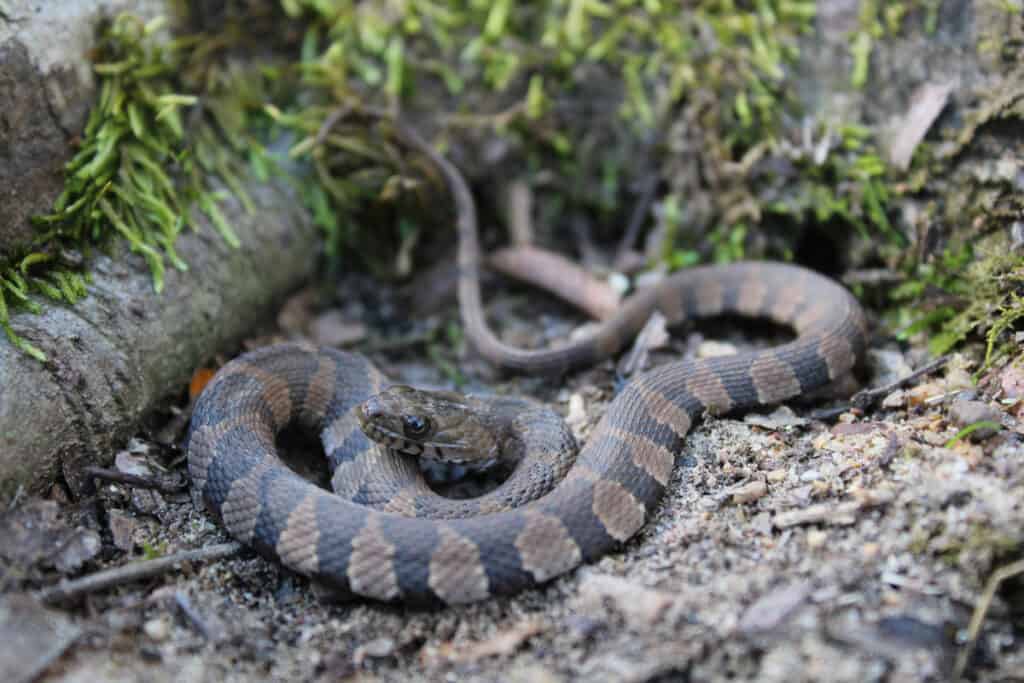
In Louisiana the midland water snake can mainly be found in the Florida Parishes.
©Tucker Heptinstall/Shutterstock.com
We’ll begin the list with a northern water snake subspecies — the midland water snake. These snakes are 24 to 30 inches long and are brown with darker crossbands which become blotches towards their tail. Their belly is yellow and features reddish-colored semi-circle markings. Midland water snakes mainly inhabit the Florida Parishes, although there is a record of them in the Ouachita Parish too. They live in lakes, rivers, ditches, and swamps where they prey on fish and amphibians.
2. Diamond-Backed Water Snake (Nerodia rhombifer)

Diamond-backed water snakes can sometimes be seen hanging from branches near the water.
©Tucker Heptinstall/Shutterstock.com
The diamond-backed water snake occurs statewide in Louisiana and inhabits most freshwater habitats. However, they tend to prefer areas where there is plenty of vegetation overhanging the water as they frequently hang from the branches while basking in the sun. Diamond-backed water snakes are 30 to 48 inches long and have brown bodies with dark brown to black blotched markings on their sides. These have black diagonal lines between them which form the distinctive diamond pattern that they are named for. These snakes will bite if they are threatened, although they are not venomous.
3. Plain-Bellied Water Snake (Nerodia erythrogaster)
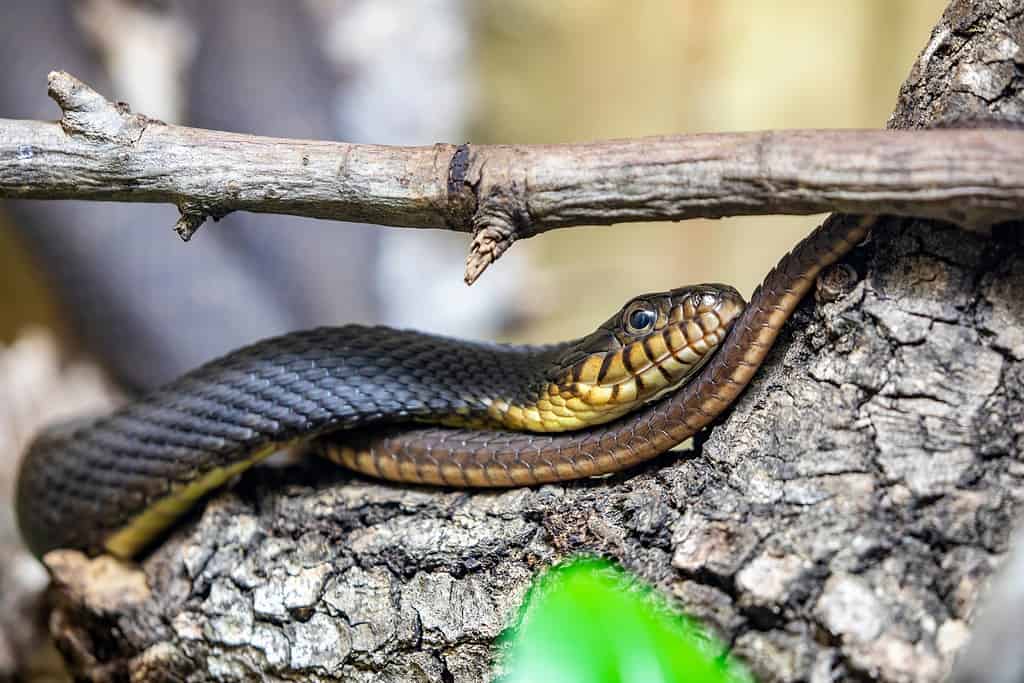
Plain-bellied water snakes prefer slow-moving bodies of water.
©Danny Ye/Shutterstock.com
The next water snake in Louisiana is the plain-bellied water snake. Plain-bellied water snakes are 30 to 48 inches long and have olive green to gray bodies. They also have a plain belly which is typically yellowish colored and results in them also being known as yellow-bellied water snakes. These snakes occur almost statewide and often inhabit large, slow-moving areas of water, such as swamps and lakes. Plain-bellied water snakes predominantly eat fish and amphibians which they grab and swallow alive.
4. Mississippi Green Water Snake (Nerodia cyclopion)

The Mississippi green water snake is found only in the southeastern United States.
©Ryan M. Bolton/Shutterstock.com
The Mississippi green water snake is a dark, greenish brown snake which is typically between 30 and 45 inches long. These snakes are found throughout most of Louisiana, although they are not as common in the upper Florida Parishes, the western, and the northern regions. Mississippi green water snakes prefer slow-moving bodies of water, such as lakes, pond, swamps, and bayous. They mainly prey on fish and amphibians. Mississippi green water snakes are not venomous and prefer to flee back into the water if they are disturbed. However, they will bite as a last resort and release a strong musk smell.
5. Gulf Salt Marsh Snake (Nerodia clarkii clarkii)
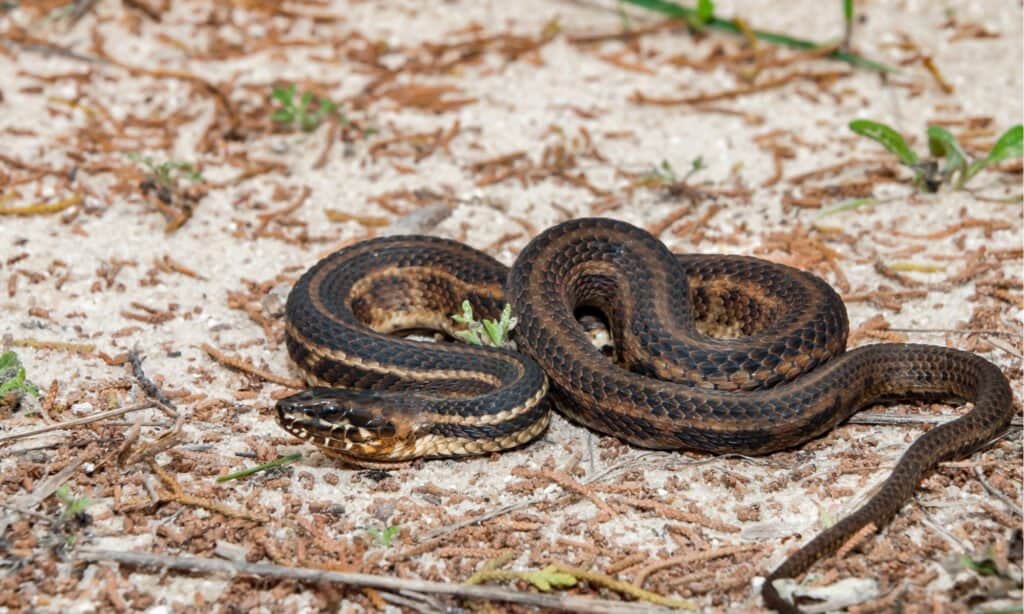
The Gulf salt marsh water snake can be found along the coast in habitats with brackish water.
©Jay Ondreicka/Shutterstock.com
The Gulf salt marsh snake is one of three subspecies of the saltmarsh snake. These are typically 15 to 30 inches long and are grayish brown with two yellowish-colored stripes along each side. They also have 21 to 23 keeled dorsal scales. Gulf salt marsh snakes are only found in the coastal region of Louisiana where they inhabit brackish water and salt marshes. They prey on shrimp, crabs, and fish which they find trapped in water pools caused by the receding tide. They are mainly nocturnal and hide in the vegetation during the day.
6. Banded Water Snake (Nerodia fasciata)
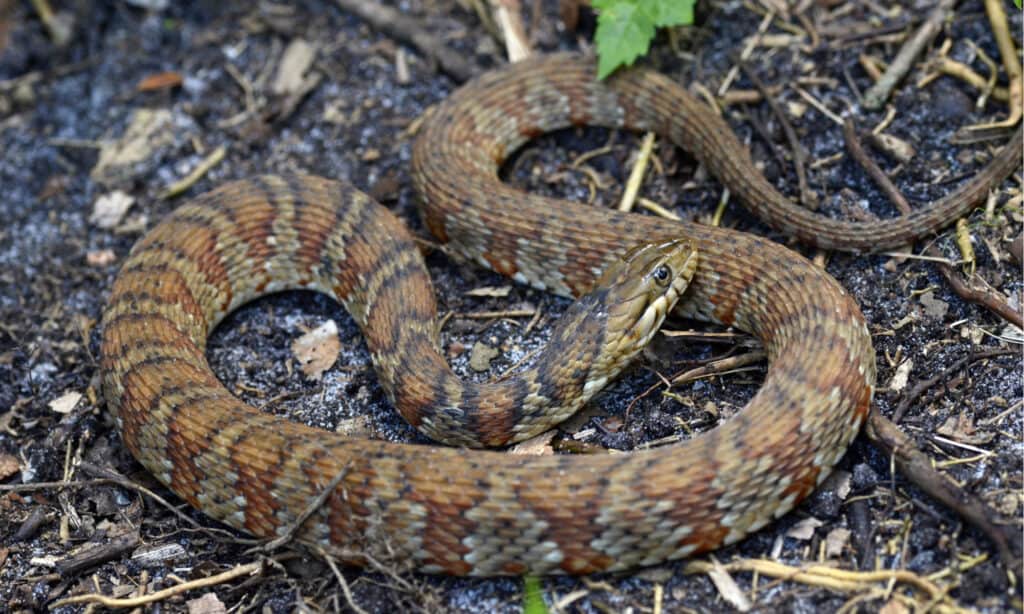
Banded water snakes are not venomous but will bite if they are threatened.
©Patrick K. Campbell/Shutterstock.com
The next snake is the banded water snake which is also sometimes called the southern water snake. These are one of the most common water snakes in Louisiana and occur statewide. Banded water snakes prefer shallow, slow-moving water — including swamps, bayous, lakes, and ponds. They are not venomous but will readily bite to defend themselves against any potential threat. Banded water snakes typically range between 22 and 42 inches long. They are dark brown and have large crossbands in a lighter brown or red.
7. Northern Cottonmouth (Agkistrodon piscivorus)
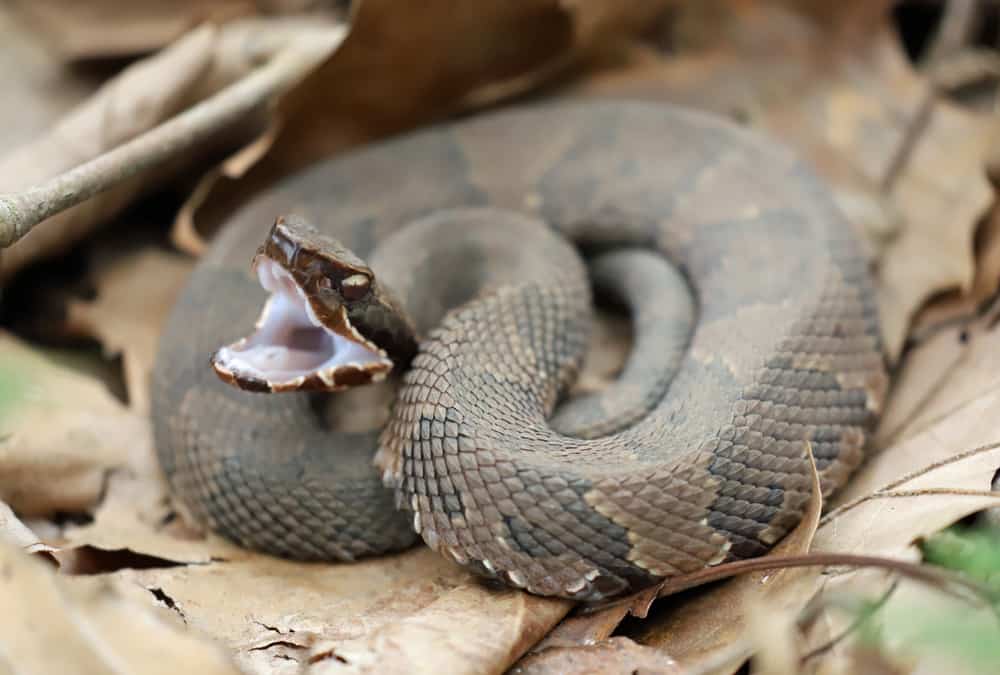
Cottonmouths possess cytotoxic venom which can cause extensive tissue damage.
©KF2017/Shutterstock.com
The only venomous snake on the list, and the only semi-aquatic pit viper in the US, is the northern cottonmouth. Cottonmouths typically measure 30 to 42 inches long and have heavy, dark brown bodies with black crossbands, although sometimes they can be so dark that they appear to be almost black. However, the feature that distinguishes them the most is their mouth. This is because the lining of it is bright white. These snakes often expose it when they open their mouth wide in a defensive posture. Cottonmouths occur statewide in Louisiana and live in most freshwater habitats. They contain cytotoxic venom which breaks down tissue and can lead to extensive damage and scarring.
8. Eastern Garter Snake (Thamnophis sirtalis sirtalis)
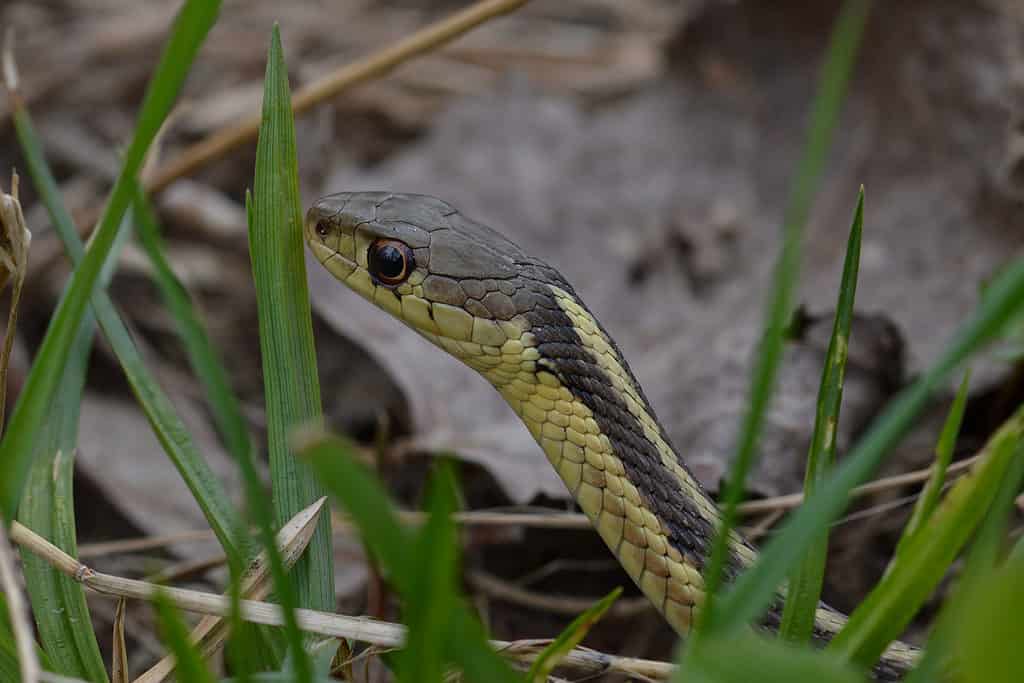
The eastern garter snake lives close to water and preys mainly on fish and frogs.
©Ryan Hodnett, CC BY-SA 4.0, via Wikimedia Commons – License
Although not a true water snake, the eastern garter snake almost always resides close to water and relies heavily on the water for food. Eastern garter snakes are a subspecies of the common garter snake and are widespread across most of Louisiana, with the exception of the west and southwestern regions. They typically inhabit wetland areas around swamps, lakes, and rivers where they prey heavily on small fish and amphibians. Eastern garter snakes are not truly venomous and pose no threat to humans. However, they produce a substance in the Durvenoy gland which is similar to venom and can incapacitate their prey when they chew it into them. They are approximately 26 inches long and are usually brown with yellow stripes.
9. Glossy Crayfish Snake (Liodytes rigida)
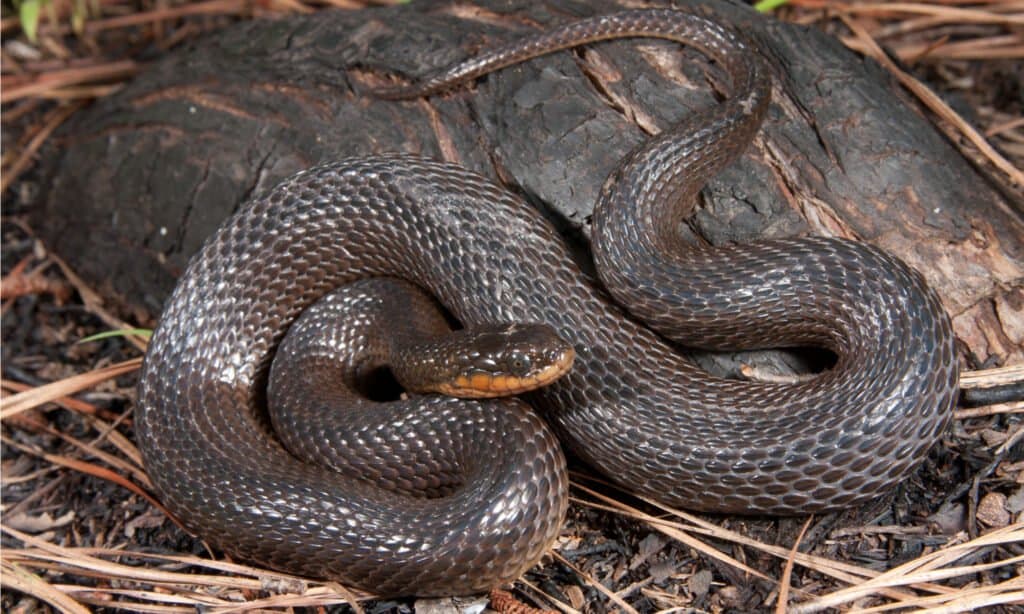
Glossy crayfish snakes live in slow-moving water where there is plenty of vegetation.
©Nathan A Shepard/Shutterstock.com
The next water snake in Louisiana is the glossy crayfish snake which is sometimes called the swamp snake. Glossy crayfish snakes range between one to two feet long and have shiny brown or olive green bodies with smooth scales. They also have usually have thin, yellowish-colored stripes, yellow lips, and yellow bellies. Glossy crayfish snakes are widespread across the majority of the state, although they are less common in the Florida Parishes. They live in most slow-moving water sources, but prefer areas with plenty of thick aquatic vegetation.
10. Graham’s Crayfish Snake (Regina grahamii)
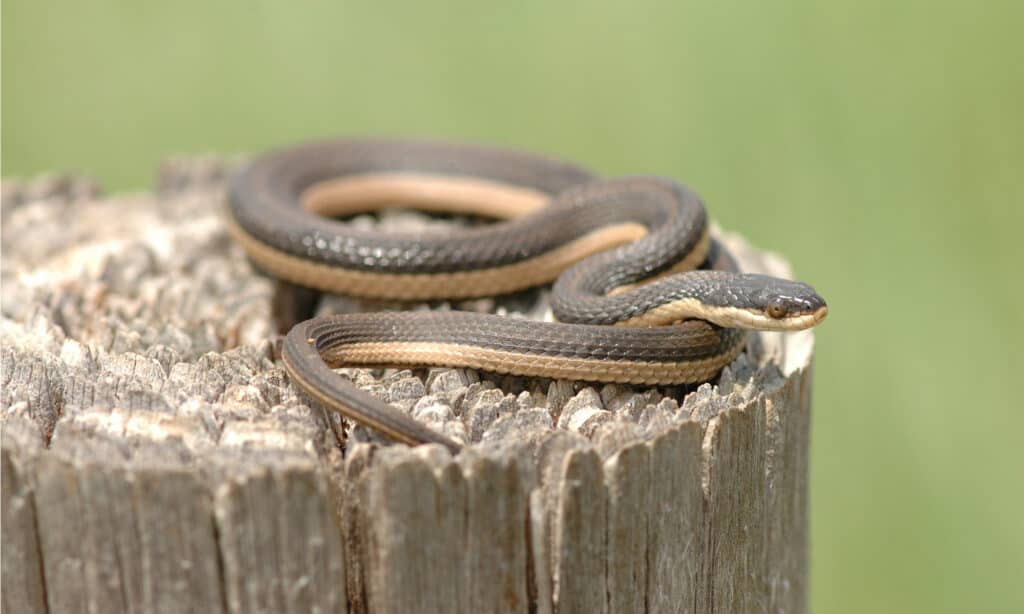
Graham’s crayfish snake is commonly seen around ponds and other slow moving bodies of water.
©Rusty Dodson/Shutterstock.com
Another crayfish snake is Graham’s crayfish snake which is common throughout most of Louisiana, with the exception of the Florida Parishes, the northern region, and parts of the western-central area. Graham’s crayfish snakes typically live in swamps, oxbow lakes, ditches, and muddy-bottomed rivers and streams. The majority of their diet consists of crayfish, although they do sometimes prey on fish and amphibians as well. These snakes are approximately 18 to 26 inches long and are grayish-brown with a yellow belly.
11. Western Ribbon Snake (Thamnophis proximus)
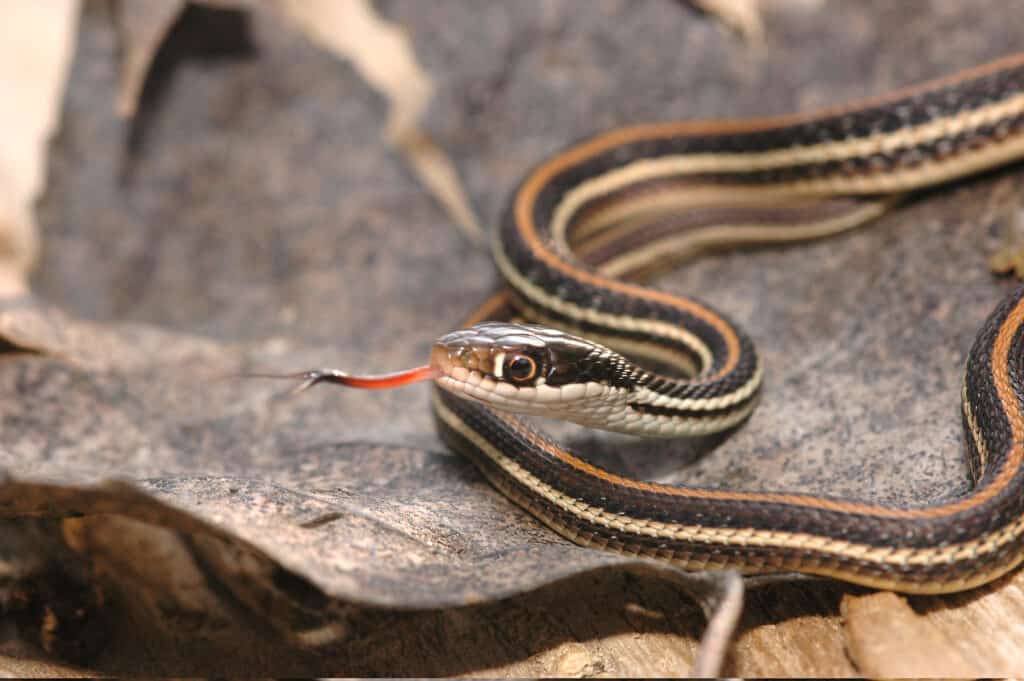
There are two species of western ribbon snakes in Louisiana.
©iStock.com/Shoemcfly
There are two subspecies of the western ribbon snake in Louisiana — the Gulf Coast ribbon snake and the orange-striped ribbon snake. Both live in and around water sources such as swamps, rivers, and streams. However, the orange-striped ribbon snake lives in the northern half of the state, while the Gulf Coast ribbon snake occurs in the southern half. They are 16 to 42 inches long and can be either black or brown with orange, yellow, or white stripes.
The photo featured at the top of this post is © Laurie L. Snidow/Shutterstock.com
Discover the "Monster" Snake 5X Bigger than an Anaconda
Every day A-Z Animals sends out some of the most incredible facts in the world from our free newsletter. Want to discover the 10 most beautiful snakes in the world, a "snake island" where you're never more than 3 feet from danger, or a "monster" snake 5X larger than an anaconda? Then sign up right now and you'll start receiving our daily newsletter absolutely free.
Thank you for reading! Have some feedback for us? Contact the AZ Animals editorial team.






